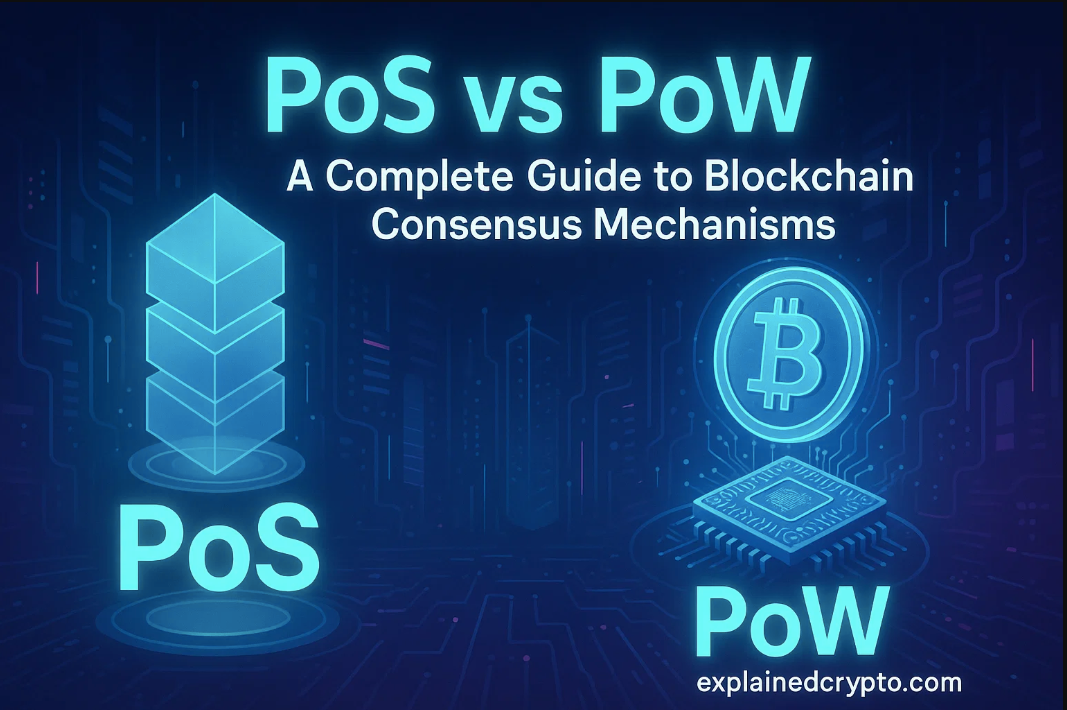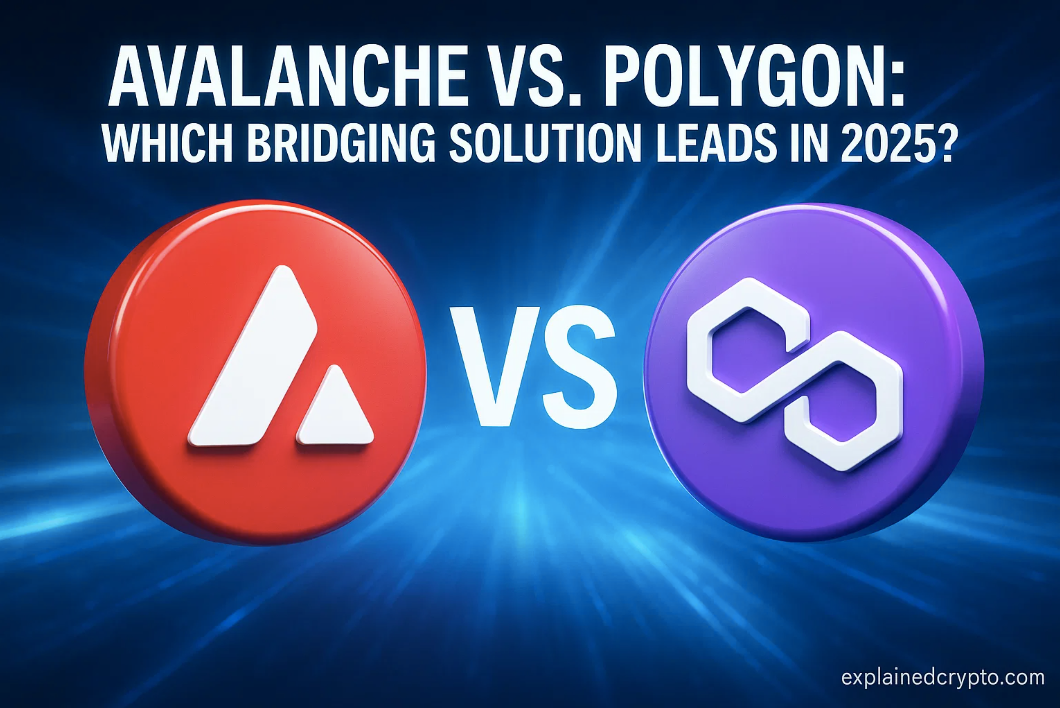Every blockchain relies on consensus mechanisms — the rules by which thousands of computers worldwide agree on the state of the network. Without consensus, blockchains would be vulnerable to manipulation, double-spending, and fraud.
The two most widely debated mechanisms are Proof of Work (PoW) and Proof of Stake (PoS). PoW, pioneered by Bitcoin, secures networks through computational power and mining. PoS, made mainstream by Ethereum’s 2022 “Merge,” relies on validators staking coins instead of solving complex puzzles.
This beginner’s guide explores how PoW and PoS work, their differences, pros and cons, and what they mean for the future of blockchain.
What Is Proof of Work (PoW)?
Proof of Work is the original blockchain consensus model introduced by Bitcoin’s whitepaper in 2008.
In PoW, miners compete to solve complex mathematical puzzles. The first to solve the puzzle gets to add the next block to the blockchain and earns a block reward in cryptocurrency. This requires massive computational power and energy.
Key Features of PoW:
- Security: Attacking the network requires enormous energy and hardware investment.
- Decentralization: Mining is open to anyone with hardware, though large mining pools dominate.
- Proven Reliability: Bitcoin has operated securely for over 15 years under PoW.
What Is Proof of Stake (PoS)?
Proof of Stake was designed as a more energy-efficient alternative. Instead of miners, validators secure the network by “staking” cryptocurrency.
The system randomly selects validators to create new blocks based on the amount of coins staked and how long they’ve been locked up. Validators earn transaction fees (and sometimes staking rewards) for honest behavior.
Key Features of PoS:
- Energy Efficiency: Requires minimal power compared to PoW.
- Accessibility: Anyone with tokens can stake, reducing reliance on costly mining rigs.
- Scalability: Faster transaction times and lower fees on many PoS blockchains.
PoW vs PoS: Side-by-Side Comparison
| Aspect | Proof of Work (PoW) | Proof of Stake (PoS) |
|---|---|---|
| Introduced By | Bitcoin (2009) | Peercoin (2012), Ethereum 2.0 (2022 mainstream) |
| Validation Method | Mining via computational puzzles | Validators stake coins |
| Energy Use | High (est. Bitcoin ~100–120 TWh/year) | Low (99.9% less energy than PoW) |
| Security Basis | Cost of energy and hardware | Economic stake at risk |
| Accessibility | Requires expensive mining rigs | Accessible to anyone with stakeable coins |
| Speed & Scalability | Limited (BTC ~7 TPS) | Higher (ETH ~20–30 TPS; Solana >1,000 TPS) |
| Risk Factors | Centralized mining pools, energy criticism | Wealth concentration, “nothing at stake” problem |
The Case for Proof of Work: Why It Still Matters
Despite environmental criticism, PoW remains a cornerstone of blockchain security.
- Battle-tested: Bitcoin has never been hacked at the consensus level.
- Physical Cost Security: PoW’s reliance on real-world energy makes attacks impractical.
- Neutral Access: In theory, anyone with hardware can mine, though industrial-scale farms dominate.
PoW’s defenders argue that its energy expenditure is what gives Bitcoin intrinsic value, similar to gold mining.
The Case for Proof of Stake: Why Ethereum Switched
Ethereum’s transition to PoS in 2022 cut its energy use by over 99.9%, drawing praise from environmental groups and regulators.
Advantages include:
- Eco-Friendly: No more reliance on energy-hungry mining.
- Scalability: Easier to upgrade with sharding and Layer 2 solutions.
- User Participation: Millions of users can stake Ethereum from wallets or exchanges.
However, critics warn that PoS favors the wealthy, since larger stakers have higher odds of validation rewards.
Security Concerns: PoW vs PoS
Both mechanisms face unique risks:
- PoW Attacks: A 51% attack requires controlling majority mining power — nearly impossible on Bitcoin but feasible on smaller PoW coins.
- PoS Attacks: Large stakeholders could collude, leading to centralization. But mechanisms like “slashing” (penalizing malicious validators) add deterrence.
| Threat | PoW | PoS |
|---|---|---|
| 51% Attack Cost | Extremely high on Bitcoin | Expensive but easier if coins concentrated |
| Centralization Risk | Mining pools dominate hashing power | Exchanges and whales control staking |
| Environmental Criticism | High carbon footprint | Very low footprint |
| Long-Term Resilience | Proven for 15 years | Still relatively new at scale |
Industry Adoption: Who Uses What?
- PoW Leaders: Bitcoin, Litecoin, Dogecoin, Monero.
- PoS Leaders: Ethereum, Cardano, Solana, Polkadot, Avalanche.
- Hybrid Models: Some blockchains (e.g., Decred, Algorand) experiment with PoW+PoS hybrids.
The trend is clear: most new blockchains launch with PoS for scalability and sustainability. But Bitcoin shows no signs of leaving PoW, cementing its role as “digital gold.”
The Future of Blockchain Consensus
Looking ahead, consensus mechanisms will likely evolve into hybrid and adaptive models.
- PoW for Security Backbone: Likely to remain in Bitcoin, preserving its role as the most secure blockchain.
- PoS for Scalability & Efficiency: Expected to dominate smart contract and DeFi ecosystems.
- Interoperability & Innovation: AI-managed consensus, cross-chain validation, and hybrid approaches may blend the best of both worlds.
The debate is not about PoW vs PoS in absolute terms but which model fits the right blockchain use case.
Also Read: What is Bitcoin? A Beginner’s Guide to the World’s First Cryptocurrency
Choosing Between PoW and PoS
For beginners, the distinction between PoW and PoS boils down to energy vs efficiency. PoW offers unmatched security and reliability, while PoS delivers scalability and sustainability.
Both systems have strengths and weaknesses, and the blockchain industry is big enough for both to thrive. Bitcoin’s PoW may remain the ultimate store of value, while Ethereum’s PoS leads innovation in Web3.
The consensus debate highlights a bigger truth: blockchain is not static. Consensus mechanisms will keep evolving as the industry balances security, decentralization, and efficiency.
Disclaimer: The information in this article is for general purposes only and does not constitute financial advice. The author’s views are personal and may not reflect the views of explainedcrypto.com. Before making any investment decisions, you should always conduct your own research. explainedcrypto.com is not responsible for any financial losses.





